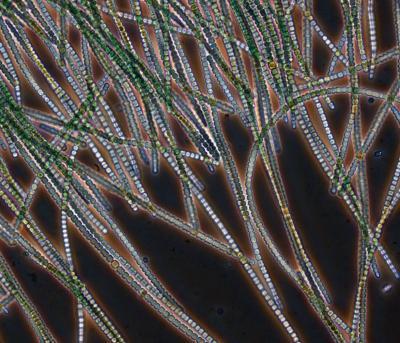Cyanobacteria belong to the Earth's oldest organisms. They are still present today in oceans and waters and even in hot springs. By producing oxygen and evolving into multicellular forms, they played a key role in the emergence of organisms that breathe oxygen.
A team of scientists under the supervision and instruction of evolutionary biologists from the University of Zurich wrote a paper showing that cyanobacteria developed multicellularity around one billion years earlier than eukaryotes (cells with one true nucleus) and at almost the same time as multicellular cyanobacteria appeared, a process of oxygenation began in the oceans and in the Earth's atmosphere.
The scientists analyzed the phylogenies of living cyanobacteria and combined their findings with data from fossil records for cyanobacteria. According to the results recorded by Bettina Schirrmeister and colleagues, multicellular cyanobacteria emerged much earlier than previously assumed. «Multicellularity developed relatively early in the history of cyanobacteria, more than 2.3 billion years ago», Schirrmeister explains in her doctoral thesis, written at the University of Zurich.
Link between multicellularity and the Great Oxidation Event
According to the scientists, multicellularity developed shortly before the rise in levels of free oxygen in the oceans and in the atmosphere. This accumulation of free oxygen is referred to as the Great Oxidation Event, and is seen as the most significant climate event in the Earth's history. Based on their data, Schirrmeister and her doctoral supervisor Homayoun Bagheri believe that there is a link between the emergence of multicellularity and the event.
According to Bagheri, multicellular life forms often have a more efficient metabolism than unicellular forms. The researchers are thus proposing the theory that the newly developed multicellularity of the cyanobacteria played a role in triggering the Great Oxidation Event.
The increased production of oxygen set the Earth's original atmosphere off balance. Because oxygen was poisonous for large numbers of anaerobic organisms, many anaerobic types of bacteria were eliminated, opening up ecological 'niches'. The researchers have determined the existence of many new types of multicellular cyanobacteria subsequent to the fundamental climatic event, and are deducing that these occupied the newly developed habitats. «Morphological changes in microorganisms such as bacteria were able to impact the environment fundamentally and to an extent scarcely imaginable», concludes Schirrmeister.

This shows a multicellular cyanobacterium.Credit: Picture: UZH






Comments